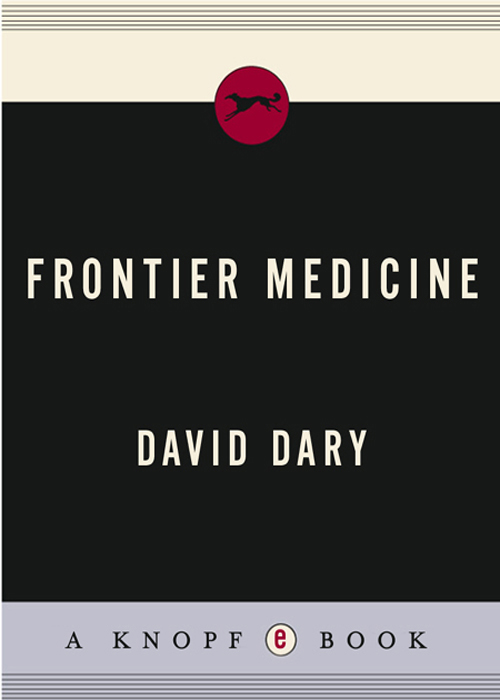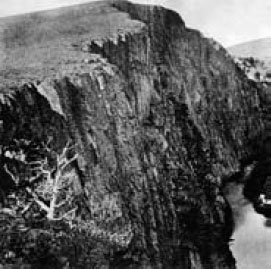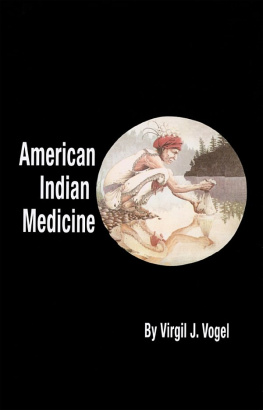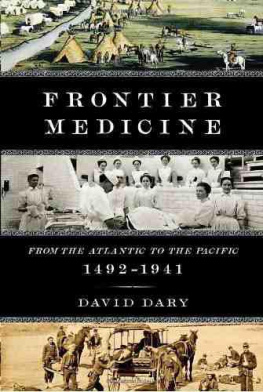

CONTENTS
PREFACE
One day a cowboy in the Old West was asked how his workday had gone. He responded, Well, I started up one canyon and came out another. The cowboy meant hed started out in one direction but soon found he was going in another. So it was with this book.
When I embarked on the research, my focus was on medicine in the American West only during the nineteenth and early twentieth centuries. But it soon became evident that what can be considered the frontier period of American medicine began much earlier, with the arrival of the first Europeans during the sixteenth century, and did not really end until about 1941, just before U.S. entry into World War II. And a major part of this long story lies in the contribution of American Indians, whose herbal and psychological lore were combined by early European settlers with the medical theories and practices they brought with them. It is fair to say, in fact, that Indian medical knowledge is what gives early American medicine its particular character, and this rare combination becomes the true foundation for the growth and slow evolution of our practice of medicine, especially during the era of westward expansion following the American Revolution.
This book, then, is the story of that extended frontier period. It tells of the people involved and describes the contributions of Indians and of frontiersmen, explorers, and settlers of European origin, of mountain men, fur traders, immigrants bound for Oregon and California or the promised land of Utah, and soldiers from revolutionary times to beyond the Civil War and the Indian Wars that followed. Individual chapters tell the stories of each of these groups and discuss medicine on homesteads, on ranches, in towns, and in the picturesque and pristine West that attracted health-seekers. Also included are stories about midwives and other women who fought to break the barriers imposed by male opposition to their entry into the field. There are also chapters about patent medicines and quacks of every stripe. The book concludes with a chapter that sketches the significant changes that occurred during the early twentieth century, when American medicine moved steadily toward, and at last achieved, the status of a fully scientific enterprise.
In no way is this work definitive. It sketches in broad outline the story of how medicine struggled, evolved, and ultimately emerged from its frontier period. Certainly, the forces that have shaped it since the Revolution still exist. But they have largely taken on different forms in an atmosphere where scientific methods are now of greater influence than the botanical medicine and the often primitive beliefs and superstitions that once dominated the profession. Todays medicine, more subject to scientific practices, along with better education, scholarship, and the development of standards, is responsible for Americans living longer than their ancestors.
The history of frontier medicine in America between 1492 and 1941, as sketched between this books covers, is important to the understanding of the medicine of today and the changes that undoubtedly will continue to occur in the future. Medicine will change, and perhaps it will someday bring good health to all American citizens.
David Dary
Along Imhoff Creek
Norman, Oklahoma
CHAPTER ONE
INDIAN MEDICINE
Wisdom begins in wonder.
Socrates
M AY IS A DELIGHTFUL TIME to visit the Wichita Mountains in southwestern Oklahoma. The little bluestem, the big bluestem, switch, Indian, and grama grasses are green after their winter sleep, and the wildflowers display a variety of colors. Groves of post oak, blackjack, and eastern red cedar dot the landscape. Countless birds, including rare black-capped vireos, search for nourishment. Everywhere there is a promise of nurture and it warms the soul, as do the warm and gentle breezes from the south. The Wichita Mountains are about 300 million years old, and among the oldest mountain ranges on earth. They consist of two rugged ranges of red granite reaching nearly 2,500 feet at the highest point. They run several miles east and west and enclose a natural prairie where buffalo, elk, prairie dogs, and other wildlife still roam in what is today the Wichita Mountains Wildlife Refuge administered by the U.S. Fish and Wildlife Service. While the Wichitas may lack the majesty of the Rocky Mountains, they are impressive islands projecting upward from a sea of rolling prairie.1
The Wichitas are rich in lore which includes legends of Indian battles and Spanish treasure. The Spanish penetrated the area in the 1600s, and French traders first traversed the region during the 1770s. Long before the first Europeans arrived, Indians found protection from their enemies in the Wichitas. They also found solace at what is called Medicine Bluff, located near the eastern edge of the mountains. The bluff rises three hundred feet above a creek whose waters were thought by Indians to have special qualities. IndiansWichitas, Comanches, and Kiowasmost likely named the bluff in their native languages, designing it as a place of mystery with great spiritual powers. The first white men in the area named it Medicine Bluff after learning of this Indian belief. The word medicine probably derived from mdecin, the French word for physician, which early French fur traders would have introduced into North America. The term was widely applied by whites. In time, Indians used the word to identify their own healing methods and spiritual mysteries.
Medicine Bluff is just one of countless natural places with distinctive features that Indians believed had special spiritual power because they could not rationally explain why they existed. Such natural places conveyed to them the essence of a religious experience but were not actually worshipped. Not all things with spiritual power, to be sure, were natural. Indians created smoking pipes, bundles, and other objects that became sacred and powerful once the makers performed special rituals to imbue them with qualities of sacredness or good medicine. For the American Indian, almost anything could attain such a therapeutic or mystical quality, emphasizing how great a role spiritual power plays in Indian medicine.

This view of Medicine Bluff in the Wichita Mountains of southwestern Oklahoma was copied from a mid-twentieth-century postcard. The bluff rises three hundred feet above Medicine Creek. (Authors collection)
In Letter Six of his Letters and Notes on the Manners, Customs, and Conditions of North American Indians (1844), the artist George Catlin noted that Indian country is full of doctors, and as they are all magicians, and skilled, or profess to be skilled in many mysteries, the word medicine has become habitually applied to every thing mysterious or unaccountable and the English and Americanshave easily and familiarly adopted the same word, with a slight alteration, conveying the same meaning; and to be a little more explicit, they have denominated these personages medicine-men, which means something more than merely a doctor or physician.

Next page







